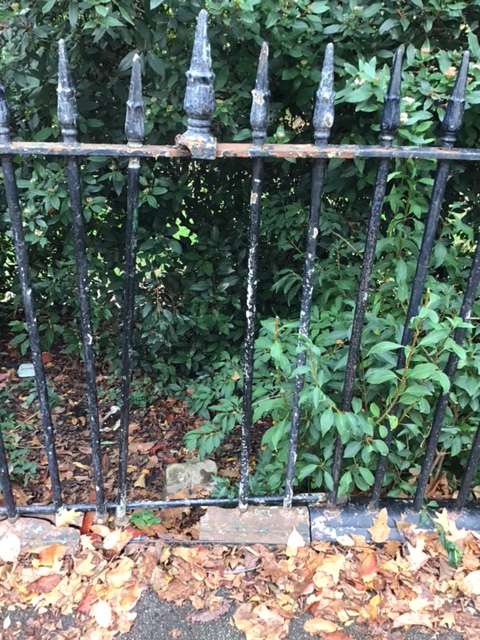
Category Archives: Parks and gardens
The first signs of spring in Thornhill Square Garden
Meet friends and neighbours in Bridgeman Road on Sunday 16 October

On Sunday 16 October, from 14:00 to 17:00, Bridgeman Road will have its first official use as a play street.
Children will be safe to ride bikes and scooters, make new friends, play games and draw on the street. Adults will be able to chat. Everyone will have chances to plant bulbs.
The road will be closed to traffic temporarily, but residents and visitors will be able to drive in and out at walking speed guided by a steward.
‘Best Community Garden’ award for Thornhill Square Garden

Anna McKane, who has been leading the volunteer gardening work so effectively since it started, says:
It is thrilling that we have won second prize in the Islington in Bloom competition: the gardens have changed beyond all recognition in the past five years, and they are a testament to the enormous amount of work that many volunteers have put in.
You can find out about silver gilt awards, best community gardens and the expectations for the competition entries here. The award is worth £120 in tools or plants.
A proposal for the railings of Thornhill Square Garden


The cast iron railings around Thornhill Square Garden are the original Victorian ones, except mainly on Bridgeman Road. They are listed and have been put on the Building at Risk Register; the few repairs which have been done are mostly unsatisfactory. Children can escape through the holes and run onto the road. For over thirty years the Thornhill Square Association has been asking Islington Council to repair them.
In 2010 English Heritage (now Historic England) gave a grant for repairs to two lengths of railing, one opposite 6 and 7 Thornhill Square and the other by the west gate. The railings were removed, cleaned, primed, reconstructed with missing items replaced, and finally painted. The cost of £35,000, if factored up to carry out these repairs around the garden, would have been £705,000. A similar repair this year was quoted at £1,963,050.
An application to the National Lottery in 2016 for funding repairs to the railings and improvements to the garden was eventually not submitted because the cost was too great. However, Historic England did provide another grant to survey the railings. As part of this, Hall Conservation Ltd. estimated a budget of £200,000 for carrying out much less aggressive repairs, which would not have dismantled all the railings. They suggested earlier this year that it would be £240,000.
Patrick Firebrace, a resident who has spent much of his working life with Concrete Repairs Ltd., has put forward a proposal: the damaged cast iron bases to the railings (such as that shown above) could be replaced by concrete bases. The replacements would be sturdier, cheaper and more easily procured than new cast iron bases; they would also be indistinguishable when painted. There are only three other sites in Islington with cast iron bases; all are much sturdier.
Patrick Firebrace has tried out the proposal by providing a mould, making a concrete base, repainting four standards (two black and two pale green, as in the 1920s) and cleaning the layers of old paint from the finials. The resulting railings can be seen opposite 8 Thornhill Square (and are also shown above).
Repairs are also needed to:
• Missing main posts and rakers.
• Broken rail joints.
• Missing large and small finials.
• Railings badly out of plumb or line.
• Disintegrating brick footings.
The repairs might be done by a metal worker while keeping the railings essentially intact. Preparing and painting could be done by volunteers. The Parks Department would need to cut back small trees and undergrowth to 1.5m from the railings; they have asked for the worst sections to be repaired first. Before any of this happened, funds would need to be secured and listed building consent would need to be obtained from Islington Council.
Patrick Firebrace is happy to talk to anyone who wants more information by email (at firebrace254@btinternet.com) or on site (in Thornhill Square Garden between 10:00 and 12:00 on Saturday 1 October or Saturday 5 November). The proposal will also be considered at the Thornhill Square Association annual general meeting on Monday 28 November.
The government gave grants to local authorities to improve parks before the coronation of Queen Elizabeth II in 1953. Since then there have been great efforts to maintain and enhance the garden. Should we not now commemorate the end of the reign by repairing the railings?
Tours of Thornhill Square

In the annual Open House Festival this year there will be free tours of Thornhill Square, Thornhill Crescent and Saint Andrew’s Church. They will start at 10:00, 11:00, 12:00, 14:00, 15:00 and 16:00 on Saturday 17 September, and at 14:00, 15:00 and 16:00 on Sunday 18 September, and last 30-40 minutes (with refreshments afterwards in the church). Either an architect (James Dunnett) or a resident (Philip Rutnam) will lead them.
The Thornhill Estate is a remarkable example of Georgian town planning, with the gardens of Thornhill Square and Thornhill Crescent as a central feature. It was designed by Joseph Kay, who worked also on the Foundling Estate and in Greenwich and Hastings. However, it was built in the early Victorian era, and later incorporated the unusually eclectic West Library. This was due to Beresford Pite, who was responsible also for another nearby building that is unusual (at least inside), the Paget Centre in Randells Road..
The programme of the Open House Festival has many more details here. Booking is not needed but would help the leaders know how many to expect.
Early summer in Thornhill Square Garden
The state of the railings of Thornhill Square Garden


Many people have been grateful for the open space of Thornhill Square Garden during the last year and have helped with the gardening led by Anna McKane.
However, the original listed Victorian cast iron railings around the garden are deteriorating alarmingly, with the east side being worse than the west. As the pictures above show, young children could escape through the holes in the railings onto the road and very heavy loose metal might fall on someone or even be taken as a weapon.
In the past Historic England has provided grants to repair a short section of the railings in a trial and to conduct a full survey of the defects in anticipation of completing the repair. Historic England remains keen to have the repair completed and to avoid wasting the earlier expenditure.
For thirty years we have been urging Islington Council to find ways in which the railings can be repaired before their final collapse. We are searching for such ways now.To obtain further information, make any helpful suggestions or ask to be kept informed please contact us.









